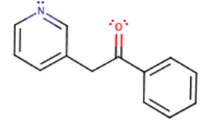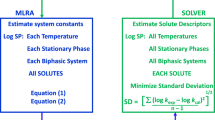Abstract
We show how the shift in the equilibrium constant K PT for formation of a proton-transfer adduct in a non-interactive solvent, upon addition of a second, hydrogen-bonding solvent S reveals the nature of the hydrogen bonding solvation process. Data are analyzed for the pentachlorophenoltriethylamine proton-transfer equilibrium in cyclohexane solvent, under-going solvation by the acidic alcohols, 2,2,2-trichloroethanol and 1,1,1,3,3,3-hexafluoro-2-propanol. K PT vs. [S] data are fitted to a binding isotherm corresponding to two-stage solvation of both the adduct and the free amine. Stoichiometries and binding constants for both primary and secondary solvation of both solvated species are determined as adjustable parameters. Best fits correspond to both the adduct and free amine under-going primary solvation by one alcohol molecule (presumably at the oxygen and nitrogen lone-pairs, respectively) followed by secondary solvation by one to nine additional alcohol molecules, with binding constants ranging from 2100 M−1, for primary solvation of the adduct by hexafluoro-2-propanol, down to 7 M−1, for secondary solvation of the amine by trichloroethanol. We speculate that the secondary solvation numbers represent average sizes of hydrogen-bonded alcohol chains, nucleated by the enhanced basicity of the primary-solvation alcohol.
Similar content being viewed by others
References
A. Reyes and R. M. Scott,J. Phys. Chem. 84, 3600 (1980);
E. D. Berman, R. Thomas, P. Stahl, and R. M. Scott,Can. J. Chem. 65, 1594 (1987);
Z. Ye, S. Yazdani, R. Thomas, G. Walker, D. White, and R.M. Scott,J. Mol. Struct. 177, 513 (1988);
M. Abduljaber and R. M. Scott,J. Mol. Struct. 237, 285 (1990);
M. Zhou, H.-W. Zhu, S. Kasham, and R. M. Scott,J. Mol. Struct. 270, 187 (1992);
H.-W. Zhu, M.S. Thesis, Eastern Michigan University, Ypsilanti (1994);
S. E. Schullery and R. M. Scott,J. Mol. Struct. 322, 287 (1994);
A. Chen, S. E. Schullery, and R. M. Scott,J. Mol. Struct. 322, 321 (1994);
N. Hemati, R. Khan, and R. M. Scott,J. Mol. Struct. 322, 379 (1994).
Th. Zeegers-Huyskens and P. Huyskens, inMolecular Interactions, Vol. 2, H. Ratajczak and W. J. Orville-Thomas, eds., (Wiley, New York, 1980);
S. Vinogradov and R. A. Linnell,Hydrogen Bonding (Van Nostrand-Reinhold, New York, 1971).
R. Stewart,The Proton: Applications to Organic Chemistry, in “Organic Chemistry”, Vol. 46, H. H. Wasserman, ed., (Academic, New York, 1985) Chap. 4;
S. K. Burley and G. A. Petsko, inAdvances in Protein Chemistry, Vol 39, C. B. Anfinsen, J. T. Edsall, F. M. Richards, and D. S. Eisenberg, eds., (Academic, New York, 1988);
J. Sponer and P. Hobza,J. Am. Chem. Soc. 116, 709 (1994).
C. L. Perrin and R. K. Gipe,Science 238, 1393 (1987);
F. Sciortino, A. Geiger, and H. E. Stanley,J. Chem. Phys. 96, 3857 (1992);
M. D. Newton,J. Phys. Chem. 87, 4288 (1983).
J. L. Chen, L. Noodleman, D. A. Case, and D. Bashford,J. Phys. Chem. 98, 11059 (1994);
M. J. Kamlet, J. L. Abboud, and R. W. Taft,J. Am. Chem. Soc. 99, 6027 (1977);
J. Zeng, J. S. Craw, N. S. Hush, and J. R. Reimers,J. Phys. Chem. 98, 11075 (1994);
M. J. Kamlet, J. L. M. Abboud, M. J. H. Abraham, and R. W. Taft,J. Org. Chem. 48, 2877 (1983).
P. Debye,Polar Molecules (Chemical Catalog Co., 1929; reprinted by Dover Publications, New York), Chap. 3;
G. M. Barrow,Physical Chemistry for the Life Sciences, 2nd edn., (McGraw-Hill, New York, 1981) p. 131.
K. A. Connors and D. Khossravi,J. Solution Chem. 22, 677 (1993);
R. W. Impey, P. A. Madden, and I. R. McDonald,J. Phys. Chem. 87, 5071 (1983);
E. M. Arnett,J. Chem. Educ. 62, 385 (1985);
N. Matubayasi, L. H. Reed, and R. H. Levy,J. Phys. Chem. 98, 10640 (1994).
M. D. Joesten and L. J. Schaad,Hydrogen Bonding (Marcell Dekker, New York, 1974);
G. C. Pimentel and A. L. McClellan,The Hydrogen Bond (Freeman, New York, 1960);
L. H. Thomas,J. Chem. Soc. 1995 (1963);
R. M. Haseldine,J. Chem. Soc. 1757 (1953);
A. Planckaert and C. Sandorfy,Can. J. Chem. 50, 296 (1972).
A. C. Legon and D. J. Millen,Chem. Soc. Rev. 71 (1992);
R. M. Baum,Chem. Eng. News 70, 20 (1992).
N. F. Dalleska, K. Honma, L. S. Sunderlin, and P. B. Armentrout,J. Am. Chem. Soc. 116, 3519 (1994).
Author information
Authors and Affiliations
Rights and permissions
About this article
Cite this article
Schullery, S.E., Hemati, N. & Scott, R.M. Determination of primary and secondary solvation numbers and binding constants based on the shift of a proton-transfer equilibrium resulting from hydrogen bonding solvation. J Solution Chem 24, 771–793 (1995). https://doi.org/10.1007/BF01131044
Received:
Issue Date:
DOI: https://doi.org/10.1007/BF01131044




